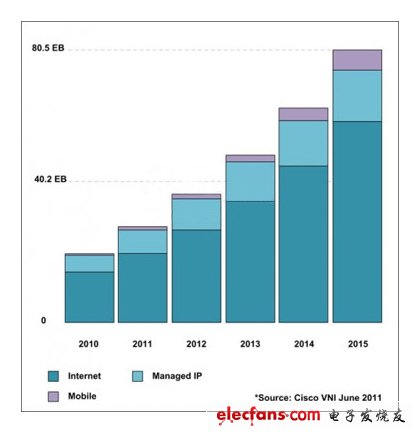After the massively popular Internet has increased cloud services (eg, Apple iCloud), the data center's pure computing and storage requirements are growing at an unprecedented rate. This growth directly affects energy consumption. As it continues to grow, engineers are looking for solutions that control power consumption. Since networked systems use connectors that exceed 10Gb (Gbps) per second, we will focus on connector power budgets and solutions to reduce the power consumption of these high-speed channels.
introduction
Today, there is no doubt that Internet data transmission is growing rapidly. Cisco's latest (June 2011) Visual Network Index (VNI) forecasting report clearly shows this trend, with its projected interest in mobile space growth (see Figure 1). After the introduction of "cloud" computing and storage, bandwidth consumption is increasing due to this novel mode. Mobile users are moving from simple text data transmission to high-definition photo and video transmission, and users urgently need to copy the content to cloud storage, transcode the video, and copy the multimedia data to a variety of devices (not to mention Published on social networks). This performance pressure ultimately requires increased processing and communication capabilities.

Figure 1: Internet bandwidth trends for 2010-2015
However, these increases come at a price – not just the cost, but also the power consumption. Designers of next-generation servers and networks have struggled with power consumption – both in terms of cost of ownership (CoO) and practical thermal design. How to build a system to improve performance and reduce power? In an era of explosive information growth, this is a never-ending battle.
First study what
As with all system designs, next-generation servers and networks should first improve performance. In a cloud computing architecture, services typically change as the load changes. It is no longer a "server" but a discrete hardware device. In most cases, the actual hardware that provides the service can be placed anywhere within the service provider's infrastructure, and its location is "uncertain" and subject to change. This performance boost is referred to as "virtualization" or encapsulation of services within the software framework, which allows services to move freely between hardware hosts. This allows service providers to change resources as needed to reduce infrastructure power consumption.
As the service is controlled, there is a large amount of "machine to machine" (M2M) activity. In most data centers, most data transfers take place between machines without connecting to the outside world. The addition of virtualization has driven the need to move from 1 Gbps connectivity (the standard on many older servers) to 10 Gbps connectivity. Today, this demand is driving the move to 25 Gbps connections. Many of these connections are less than 5 meters in length, and most are less than 1 meter in length. The reason for this is the architecture of the server cluster. A single rack places many blade servers that connect to the top (or bottom) switch of the rack. The racks are placed in rows, integrated through the hub, and then sent to other server lines or network storage.
When using a 1Gb connection, small standard lines can easily transfer data with relatively little loss of signal integrity. This is important because: 1) the airflow outside the server is reduced due to the line blocking airflow outflow; 2) the bending radius of how many wires you can arrange in the rack is determined (see Figure 2).

Figure 2: Internal wiring of the rack
After switching to 10G Ethernet, signal integrity issues became more prominent, and passive cables began to compensate with larger standard lines. The airflow/bending radius problem began to appear and installers/designers began to use fiber optic connections to solve this problem. Turning to the use of fiber brings some problems, such as high cost and high power consumption. A typical single 10G Ethernet SFP+ module consumes about 1 watt. With tens of thousands of ports, the power requirements for fiber-optic connections increase dramatically, and some of the problems associated with increased power consumption (rack temperature rise).
PufangTech`s UHF Radio Modem operates in 403~433MHz, 419~440MHz, 450~480MHz and 480~512MHz frequency band. These radio modems have air data rate of 19200bps in 25kHz channel spacing and 9600bps in 12.5kHz. These UHF radio modems work in transparent transmission, and they can ensure compatibility to most user systems and protocols. You can also change the settings in the programming mode with a Windows based program on PC.
Wide band radios can run and be achieved with higher frequencies over 1GHZ, however, this is not likely to meet the standard of range and reliability as a wide band link.
PufangTech`s UHF radio modems are perfect for SCADA, remote control and telemetry for utility distributions (water, electricity, oil & gas).
UHF Radio Modem
UHF Radio Modem,UHF Modem,UHF Data Radio Modem,Radio VHF UHF
Shenzhen PuFang Technology Co., Ltd. , https://www.hytelus.com